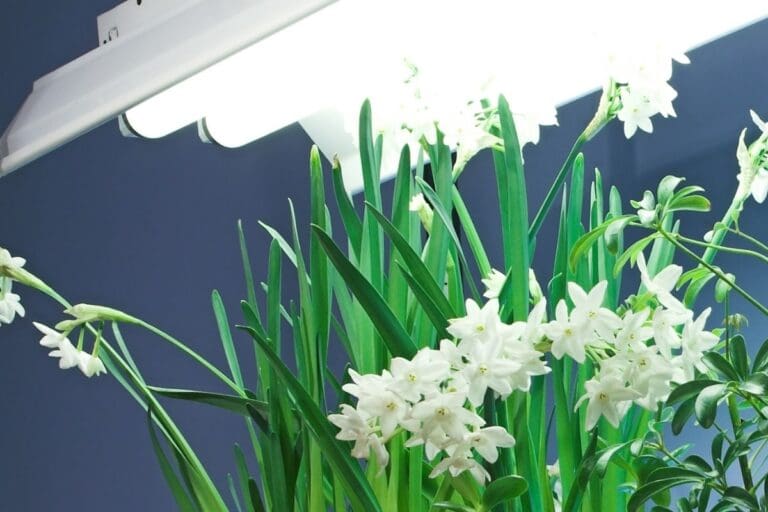String of Bananas Care Guide: Tips for Thriving Plants
Looking for a low-maintenance indoor plant that adds a touch of whimsy to your home? Let me introduce you to the String of Bananas! This charming succulent, with its cascading vines of banana-shaped leaves, is a perfect addition to any indoor space.
Curious to know the best part? It’s super easy to care for! 🌿
I’ve had my String of Bananas for a while now, and the key to keeping it happy is bright sunlight and well-draining soil. Just place it near a sunny window and ensure the soil isn’t soggy.
Trust me, with a bit of sun and the right watering routine, your String of Bananas will thrive.
One thing I’ve noticed is how quickly it takes root. After planting, give it about a month to settle in. Hold off on watering for the first 48 hours, then water deeply but sparingly.
The tiny banana-like leaves will shrivel if they get too dry, so keep an eye out. Have any tips of your own? Drop them in the comments below! 😊
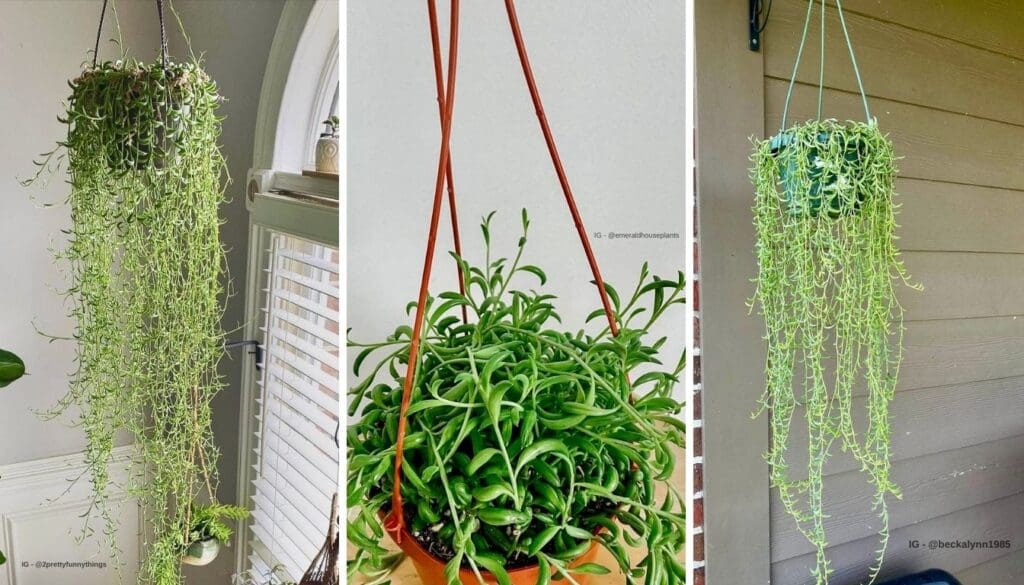
Please note: Simplify Plants is reader-supported. As an Amazon Associate, I earn from qualifying purchases made by our readers with no extra cost added to you all! Some links in the post are affiliate links and I get a commission from purchases made through links in the post.
What Are String Of Bananas?
String of Bananas, also known as Senecio radicans, is a striking succulent with unique features and a fascinating natural habitat. Let’s dive into what makes this plant so special and where it comes from. 🪴
Characteristics Of Senecio Radicans
The String of Bananas gets its name from the banana-shaped leaves that dangle elegantly from its stems. These leaves are not just pretty; they’re also succulent, storing water to help the plant survive.
The stems can grow quite long, making this plant ideal for hanging baskets. 🌿 It’s exciting to watch them drape down, creating a curtain of green.
The plant also produces small, white flowers that smell lovely, though they’re not very showy. This succulent doesn’t need much water, prefers well-draining soil, and does well in bright, indirect light. Have you ever seen a plant so easy to care for?
Origins And Habitat
The String of Bananas is native to South Africa, where it grows wild in rocky, arid regions. Imagine these beauties cascading down a rocky outcrop, soaking up the sun! ☀️
In the wild, they thrive in areas with minimal rainfall, thanks to their water-storing leaves. These plants are used to lots of sun, which is why they love bright, indirect light indoors.
Given their hardy nature, they can tolerate some variations in humidity. Isn’t it amazing how plants adapt to their environments?
Got a String of Bananas at home? Share your experiences and tips in the comments below! 🌿💬
Light Requirements
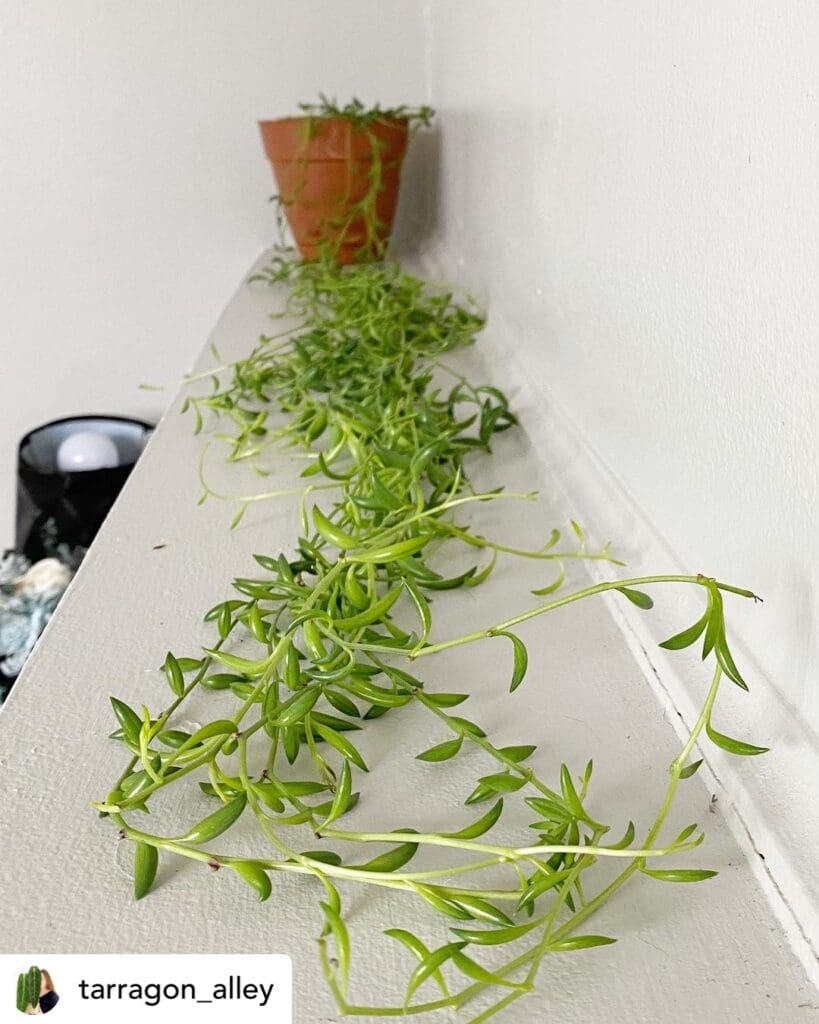
For a healthy String of Bananas plant, providing the right light is key. Let’s explore the ideal lighting conditions and how to manage sunlight exposure to keep your plant thriving at home. 🌞
Ideal Lighting Conditions
Your String of Bananas loves bright, indirect sunlight. A spot near a window that gets plenty of natural light is perfect. Direct sunlight for long periods can be too harsh and might scorch the leaves.
I like to place mine in an east-facing window. This spot gets morning sunlight, which is gentle and provides a good amount of light without the intense heat of the afternoon sun.
In case you don’t have a window that works, don’t worry! You can also use a grow light. Choose one that mimics natural sunlight and place it a few inches away from your plant. This should help your String of Bananas feel right at home. 🌿
Managing Sunlight Exposure
Too much or too little sunlight can be a problem. If the leaves start looking pale or scorched, it’s getting too much direct sun. 🥵 Simply move it a bit further from the window or provide some shade with a sheer curtain.
On the flip side, if the plant looks leggy with long stems and sparse leaves, it’s a sign of not getting enough light. 🌱 In this case, try moving it closer to the light source or get that trusty grow light.
I check my plant every couple of weeks. Adjusting its position according to how it’s reacting to the light keeps it looking lush and healthy. And hey, don’t forget to rotate your plant every now and then! This ensures all sides get an even amount of light. 🌺
👉 Do you have a favorite spot in your home where your plants thrive? Share your tips in the comments! 🌿✨
Watering Techniques
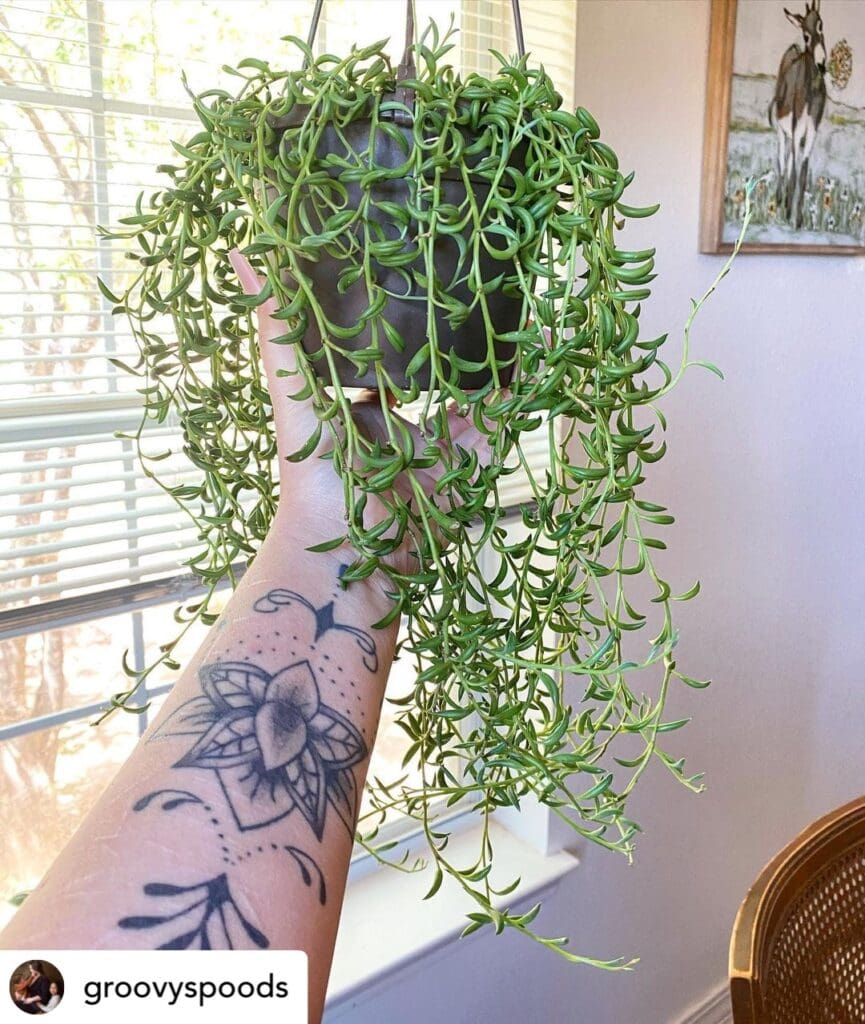
String of Bananas is a succulent that thrives when watered properly. Let’s explore the best watering schedule and how to spot overwatering or underwatering issues to keep your plant happy and healthy.
Watering Schedule
During the growing season (spring and summer), I water my String of Bananas once a week. It’s important to give it a thorough soak, allowing water to drain from the bottom of the pot. 🌱
During dormant months (fall and winter), I cut back to watering every two weeks.
A key point to remember is to always let the soil dry out completely before the next watering. This prevents the roots from sitting in water, which they really don’t like.
Do you want lush, trailing greenery? Adjusting the frequency based on your home’s humidity can make a real difference. For a quick check, I push my finger about an inch into the soil to see if it’s dry.
Signs Of Overwatering And Underwatering
Overwatering is a big no-no for succulents like String of Bananas. Some signs include yellowing leaves, a mushy texture, or even root rot, which can be tricky to recover from.
If you’ve accidentally given your plant too much love, leave it to dry out and adjust your schedule promptly.
Underwatering can also stress your plant. The leaves might start shriveling, and they won’t look as plump and juicy as they should. If you spot these signs, it’s a cue to water more often but remember, don’t drench it!
Watering can seem tricky, but once you get into the rhythm, your String of Bananas will thrive. Have you experienced overwatering or underwatering challenges? Let me know in the comments below! 🌿💧😊
Soil And Potting

When it comes to caring for your string of bananas indoors, having the right soil and potting techniques is key. Let’s get into the specifics to ensure your plant thrives.
Choosing The Right Soil Mix
Getting the right soil mix is crucial for a healthy string of bananas plant. I recommend using a well-draining, neutral soil. A standard cactus or succulent mix works wonders. These mixes typically contain ingredients like perlite and sand, which help with drainage.
Tip: You can create your own mix by combining regular potting soil with an equal part of perlite or pumice. This ensures your plant won’t sit in soggy soil, which can lead to root rot.
Keep an eye on the soil moisture, and don’t water again until the top inch feels dry.
Why do we need such a specific soil? Well, the string of bananas loves dry conditions, mimicking its natural habitat. Remember, these quirky little plants are succulents! Do you have a favorite soil mix recipe? Share it below! 🌱
Pot Repotting Guidelines
Repotting your string of bananas plant is essential for its growth. Usually, repotting every 2-3 years is a good rule of thumb. Use a pot with drainage holes to prevent water from sitting at the bottom.
When repotting, gently remove the plant and shake off excess soil. Check for any unhealthy roots and trim them. Place the plant in its new home, fill in with fresh soil, and pack it lightly around the roots to provide support.
Pro tip: Avoid watering the plant immediately after repotting. Wait around 48 hours before giving it a good soak. This helps prevent shock and root rot. Do you have any repotting hacks? I’d love to hear them! 🌿
Temperature And Humidity
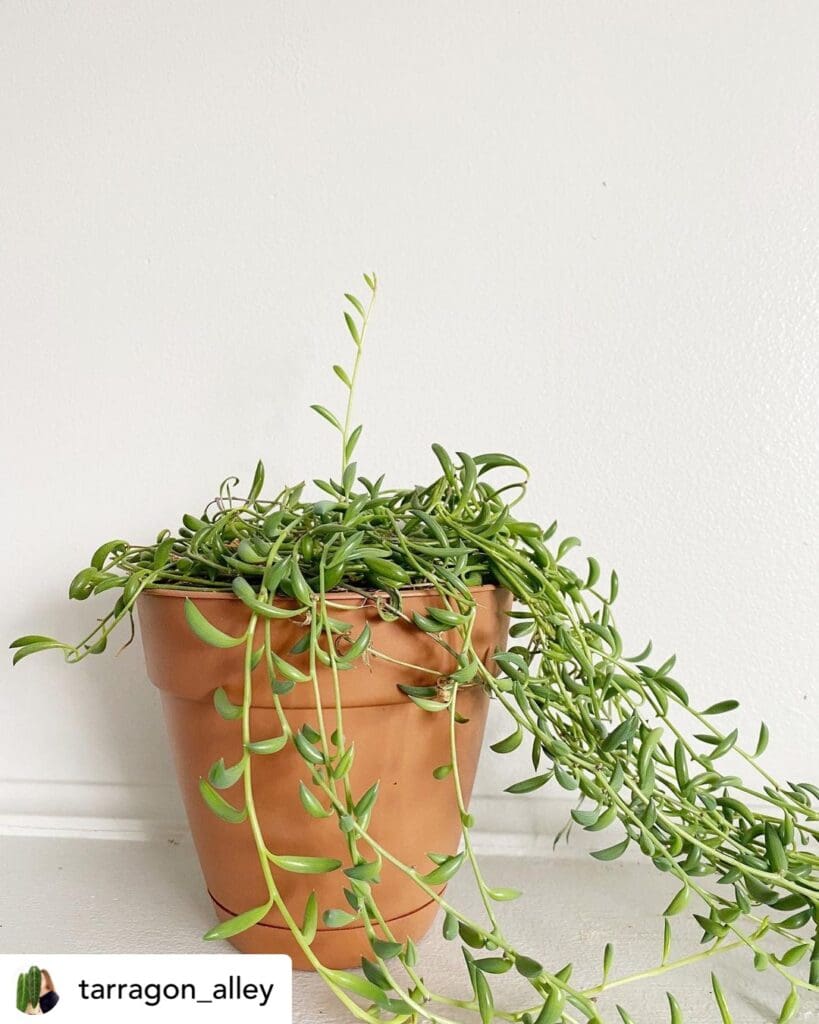
Keeping a “String of Bananas” happy indoors is all about getting the right temperature and humidity. This succulent loves consistent warmth and moderate humidity levels.
Optimal Temperature Range
My string of bananas thrives when kept in a warm environment. It enjoys temperatures between 70°F and 80°F during the day. 🌞
During the night, it can handle a small drop but prefers not to go below 50°F. If it’s too cold, the plant can suffer and may not grow well.
In winter, make sure it’s not left in a drafty spot. I always move mine away from windows or doors that might let in chilly air. Keep an eye on your thermostat and make sure your plant stays toasty!
Humidity Preferences
When it comes to humidity, my string of bananas is pretty flexible. It does best in humidity levels between 40% and 60%.
If the air is too dry, the plant might get stressed and not look its best. Too much humidity can lead to problems like rot or molds.
I like to mist my plant lightly, especially if I notice the air is really dry. But remember not to overdo it! 💦 Standing water can be a problem. Do you have a humidifier? That can also help, just don’t place it too close to the plant.
Fertilizing Your String Of Bananas

Fertilizing is important to keep your String of Bananas healthy and thriving. To get the best results, you need to choose the right fertilizer and stick to a regular feeding schedule.
Fertilizer Types
Selecting the right fertilizer can make a big difference! I recommend using a high-quality liquid fertilizer.
These are easy to mix with water and apply during your regular watering routine. You can find this type of fertilizer at most garden centers.
If you prefer organic options, you can try compost tea or a diluted fish emulsion. 🐟
These options are great for promoting healthy growth without harsh chemicals. Just remember, whichever type you use, always follow the instructions on the label.
Feeding Schedule
Consistency is key! During the growing season, from spring through fall, I fertilize my String of Bananas every 4-6 weeks. This helps the plant get the nutrients it needs to stay green and lush. 🌿
In the winter, reduce fertilization to once every 2-3 months. The plant grows slower during this time and doesn’t need as many nutrients.
Always water your plant first before applying fertilizer to avoid burning the roots.
Pruning And Maintenance
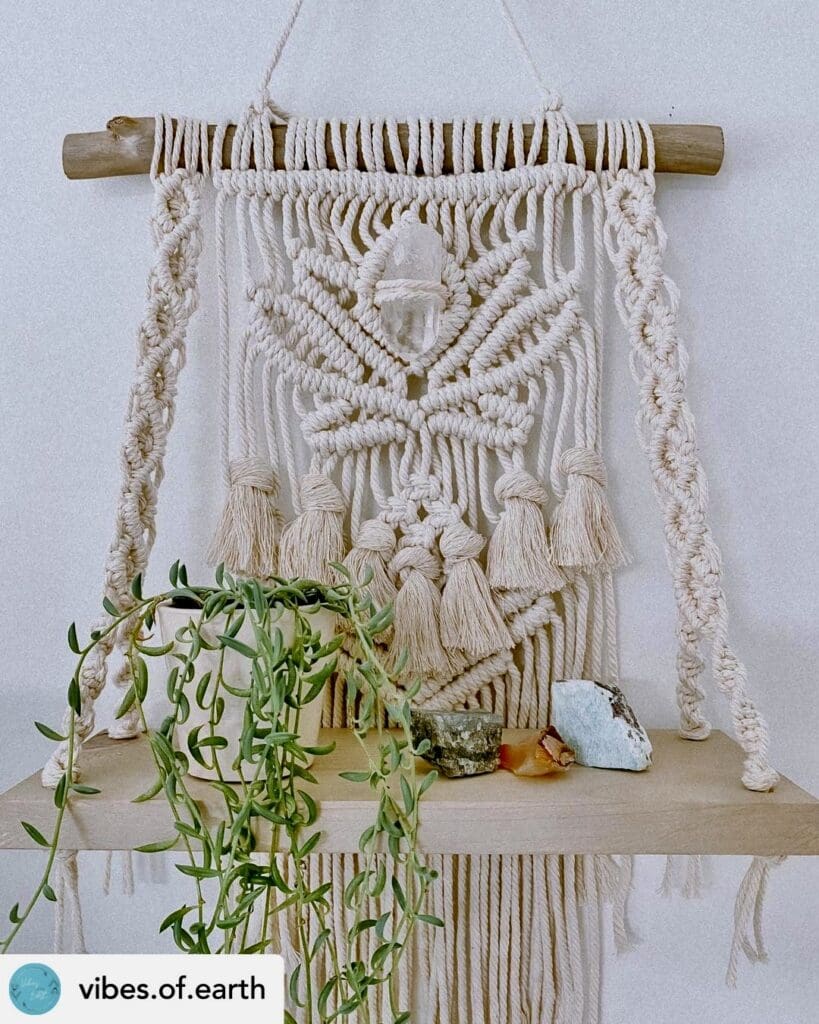
Taking care of your string of bananas involves pruning and regular maintenance to keep it healthy and looking great. Here’s when to prune your plant and some tips for keeping it in top shape.
When To Prune
Pruning is important to keep your string of bananas neat and healthy. I usually prune my plant when the stems look overgrown or start losing leaves.
Spring and summer are the best times to do this because the plant is actively growing.
Look for stems that are discolored, damaged, or overly long and snip them off with clean, sharp scissors.
Pruning helps promote new growth and keeps the plant from getting too leggy. 🌿
If you notice your plant’s growth slowing down, a quick prune can help rejuvenate it. It’s like giving it a little haircut. ✂️ Plus, you can use the cuttings to propagate new plants!
Maintenance Tips
Maintaining a string of bananas is pretty simple, but a few key practices can make a big difference.
Watering is crucial. I always let the soil dry out between waterings to prevent root rot. Over-watering is a common mistake with succulents like this one.
Sunlight is also key. My string of bananas sits by a bright, sunny window. They love ample light, but too much direct sunlight can scorch the leaves, so be mindful of that.
Check your plant regularly for pests like spider mites or aphids. If you spot any, gently wipe the leaves with a damp cloth.
A little care goes a long way in keeping your plant pest-free. 🐛
Remember to rotate your plant every now and then so it grows evenly.
Have you tried any of these tips? Share your experience in the comments below! 🌱
Propagation Methods
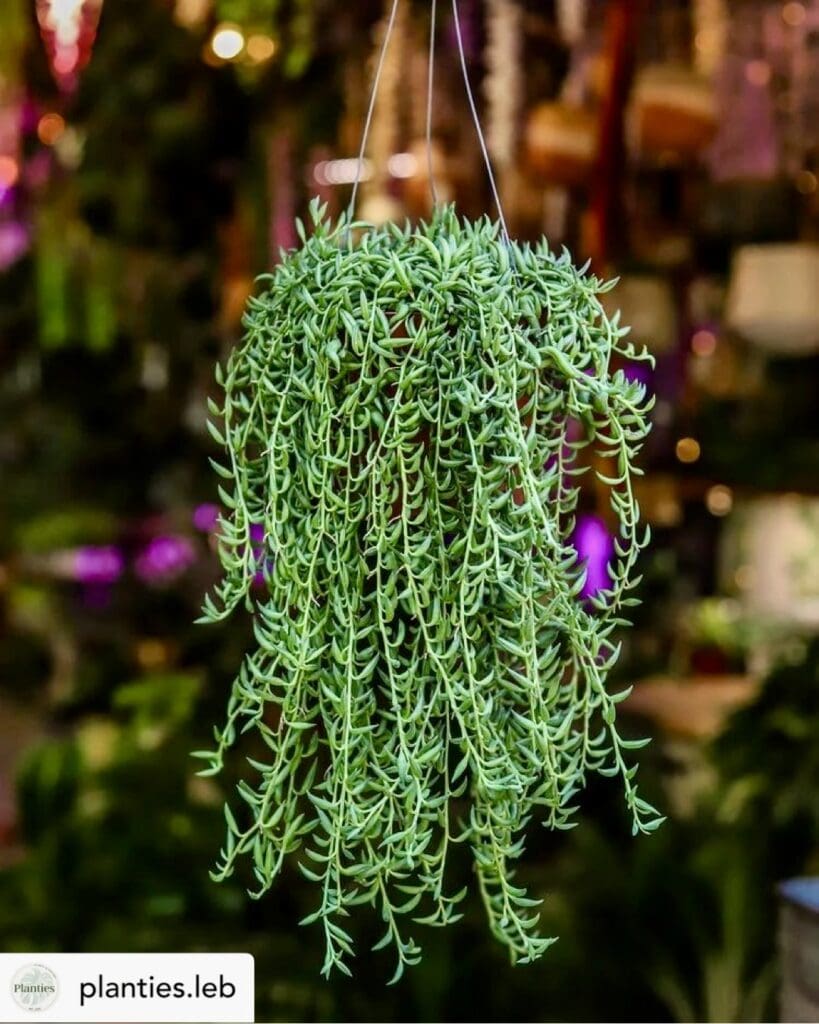
Growing new string of bananas plants can be fun and easy. There are two common ways to propagate them: using cuttings and planting them in soil.
Cuttings Propagation
To start, I like to use healthy stem cuttings. I choose a stem that’s about 4-6 inches long and has plenty of leaves. I trim the stem just below a leaf node using clean, sharp scissors or pruning shears.
Next, I remove the bottom two to three leaves from the cutting. This is a key step because it helps prepare the stem for rooting.
After that, I let the cuttings dry for about 24 to 48 hours. This helps the cut end to callus over, which prevents rot when it’s planted.
Once the cuttings are ready, I place them in a pot with well-draining soil. I prefer cactus or succulent soil because it helps prevent overwatering.
I water them lightly, keeping the soil just moist enough for the cuttings to root. 🌱
Soil Propagation
Soil propagation is another simple way to grow a new plant.
First, I fill a pot with well-draining soil. Again, cactus or succulent soil works best.
After prepping the pot, I take a healthy stem and make sure it has some leaves removed near the base.
I lay the stem on top of the soil, ensuring the cut end is touching the soil. Sometimes, I secure it with a small pin or bent paperclip if needed.
Then, I lightly mist the soil to keep it slightly moist.
Keep the pot in a spot with indirect light to avoid scorching the cuttings. Within a few weeks, the stem should start rooting into the soil. 🌿
Give it a try and let me know how it goes! Have you propagated a string of bananas before? Share your tips in the comments! 🌸
Pest And Disease Management
Keeping your String of Bananas plant healthy requires some attention to detail. Watching out for pests and preventing diseases are key to ensuring its success indoors.
Common Pests
I often get asked about the tiny invaders that might love your plant as much as you do. Mealybugs, spider mites, and aphids are the main culprits. These pests can drain the life out of your String of Bananas if not dealt with promptly.
Mealybugs appear as white, cotton-like blobs and can be wiped away with a cotton swab dipped in rubbing alcohol. Isopropyl alcohol works wonders here.
Spider mites cause tiny yellow spots on leaves. If you notice webbing, it’s time to act! A gentle spray with a mixture of water and a few drops of dish soap can help.
Aphids are tiny green insects. They can be removed by spraying water on the plant.
Disease Prevention
Most diseases in String of Bananas come from overwatering. Root rot is the biggest threat, resulting in mushy, black roots.
To avoid this, always use well-draining soil. And remember, let the soil dry out between waterings! 🌵
Another thing to watch for is powdery mildew. This looks like white powder on leaves and thrives in high humidity.
Ensure good air circulation around your plant.
Keep an eye out for yellow or brown spots, which signal fungal infections. If you see these, remove the affected areas immediately.
Do you have any tips or tricks for keeping your String of Bananas healthy? Share your thoughts in the comments! 🪴💬
Troubleshooting Common Issues
Caring for a string of bananas plant can be a joy, but sometimes problems arise. Here are solutions to common issues you might face with your plant’s leaves, stems, and growth.
Leaf Problems
If the leaves on your string of bananas plant are turning yellow or brown, it’s usually a sign of watering issues.
Overwatering often causes yellow leaves, while underwatering can lead to brown, dry leaves.
To fix this, adjust your watering schedule by letting the top half of the soil dry out before watering again. 🪴
Another common issue is pest infestation. Look for small insects like spider mites or aphids.
If you spot any, a simple solution is to wipe the leaves with a damp cloth or use a mild insecticidal soap. 🕷️
Stem Issues
Stem rot is a frequent problem, often caused by overwatering. If you notice mushy stems, it’s time to act!
Remove the affected stems and repot the plant in fresh, well-draining soil. This gives your plant a new start and should prevent further rot.
If the stems are looking weak or leggy, your plant might need more light.
Place it in a spot where it gets bright, indirect sunlight, keeping it happy and healthy.
Losing Leaves
Losing leaves is quite common but can be alarming. If you see leaves falling off, your string of bananas might be stressed by changes in environment or water.
Make sure it’s not too cold—these plants prefer warmer temperatures. 🌡️
Keep an eye on the humidity levels. If the air is too dry, misting the plant occasionally can help.
Maintaining a consistent routine with light, water, and temperature usually solves this problem.
Not Growing
Wondering why your plant isn’t growing?
Lack of growth can be due to inadequate light. Ensure it receives enough bright, indirect sunlight. Sometimes, winter months slow down growth due to lower light levels.
If lighting isn’t the issue, check the soil quality.
Using well-draining, nutrient-rich soil can boost growth. Another tip? Avoid over-fertilizing. Too much fertilizer can actually stunt growth.
Instead, fertilize once during the growing season, and your plant should thrive again.
So, have any of these tips helped with your string of bananas plant? 🌿 Share your experiences or any other questions in the comments below! Let’s grow together! 🌱✨
FAQs
How much sunlight does my String of Bananas need?
Your plant loves bright light! Aim for indirect sunlight by placing it near a sunny window. 🌞 Too much direct sun can scorch the leaves, so be careful.
How often should I water it?
Water your plant when the top half of the soil is dry. I usually touch the soil with my finger to check. 💧 Avoid letting the pot sit in water to prevent root rot.
What kind of soil is best?
String of Bananas thrives in well-draining soil. I use a cactus or succulent mix, which works perfectly. 🪴 This prevents the roots from getting too wet and rotting.
Can I propagate it?
Yes! You can propagate with stem cuttings. Cut a piece, let it dry for a few hours, and then plant it in soil. It’s super easy!
Does it need fertilizer?
It’s not necessary, but if you want to give it a boost, use a balanced liquid fertilizer every few months during the growing season.
Feel free to drop any other questions in the comments, and I’ll do my best to help! 🌱💬
Conclusion
Taking care of a String of Bananas plant is fun and pretty simple. 🌿 It just needs the right light, water, and soil.
I’ve found that giving my plant bright indirect light works best.
Have you tried placing yours near a sunny window? This helps it grow lush and green.
For watering, I wait until the soil is completely dry. Overwatering is a no-go!
Let the soil dry out between waterings to avoid root rot.
I also use well-draining soil to keep my plant healthy and happy.
Ensuring the soil doesn’t stay wet keeps my plant thriving.
When it comes to humidity, this succulent doesn’t need anything special. It adapts well to most indoor climates.
Do you have any tips or tricks for growing your String of Bananas? 🌱 Drop them in the comments below! Let’s share and learn from each other. 💬
Remember, plants are like friends—give them the care they need, and they’ll brighten up your space. Happy planting! 😊
Recommended Garden Supplies
| Product Image | Our Recommended Gardening Supplies | Check Offers! |
|---|---|---|
Top Top
Top
Top
Top
Top
Top
Top
Top | rePotme Houseplant and Tropical Classic Potting Soil Mix | Check Offer On Amazon |
 Top
Top
Top
Top
Top
Top
Top
Top | Espoma Organic Indoor Plant Food | Check Offer On Amazon |
 Top
Top
Top
Top
Top
Top
Top
Top | GooingTop LED Grow Light 6000K Full Spectrum Clip Plant Growing Lamp | Check Offer On Amazon |
 Top
Top
Top
Top
Top
Top
Top
Top | Soil Moisture Meter | Check Offer On Amazon |
 Top
Top
Top
Top
Top
Top
Top
Top | Govee Hygrometer Thermometer, Bluetooth Enabled! | Check Offer On Amazon |
 Top
Top | LEVOIT Humidifiers for Large Room(Best For Plants) | Check Offer On Amazon |
 Top
Top
Top
Top
Top
Top
Top
Top | Upgraded DIY Automatic Drip Irrigation Kit, 15 Potted Houseplants Support | Check Offer On Amazon |
 Top
Top
Top
Top
Top
Top
Top
Top | Stainless Steel Heavy Duty Gardening Tool Set | Check Offer On Amazon |
 Top
Top
Top
Top
Top
Top
Top
Top | Bonide Insecticidal Soap | Check Offer On Amazon |
 Top
Top
Top
Top
Top
Top
Top
Top | Bonide 32 oz Spray Neem Oil for Organic Gardening | Check Offer On Amazon |
 Top
Top
Top
Top
Top
Top
Top
Top | Garden Safe Fungicide | Check Offer On Amazon |







